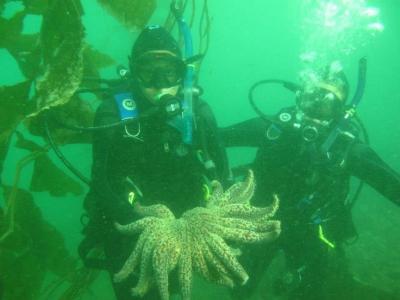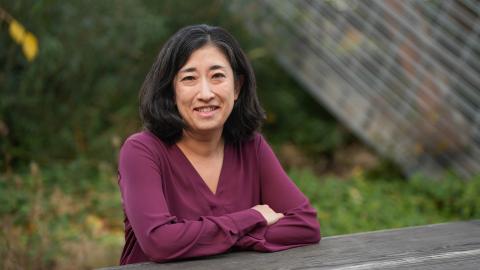Editor’s note: Lily Myers is a second-year DEOHS master's student in Occupational Hygiene and a trainee in the Northwest Center for Occupational Health and Safety (part of the UW Department of Environmental & Occupational Health Sciences). We recently spoke with Myers about her research at a Seattle-area marine mammal hospital.
How did you get interested in marine mammals? And how did you make the connection to worker health and safety?

During high school, I volunteered at a marine mammal center in Sausalito, CA. My grandma was a marine biology teacher who loved whales and collecting shells, and she kind of ignited that passion in me.
After getting my bachelor’s degree in marine science at the University of Miami, I started looking at graduate school. I came across the OHHAI program (Occupational Health at the Human-Animal Interface), a research training program offered by DEOHS through the Northwest Center for Occupational Health and Safety.
My mentor, Dr. Peter Rabinowitz, is the one who put it all together. He learned of my experience with marine mammals, and he said: Have you thought of doing a project related to that? I said: Is that an option? I genuinely had no idea I could bridge my interests and experience working with marine mammals to the field of industrial hygiene. Combining the two has been extremely exciting for me.
What is your master’s thesis project?
I am looking at whether workers are exposed to ozone coming from the water treatment system at SeaLife Response, Rehabilitation and Research (SR3), a marine mammal hospital in Des Moines, WA.
Ozone is a natural part of our atmosphere when it is high up. But ground-level ozone is a respiratory irritant. It is a common component of air pollution, created by a chemical reaction involving pollutants from sources such as car exhaust and UV light from the sun.
Ozone can also be used to treat water because it effectively destroys all types of pathogens. SR3 uses a water ozonation system to treat the pool water that flows through its animal enclosures.
For my project, I want to understand whether the water ozonation system at SR3 is giving an added dose of ozone to workers and volunteers on site. SR3 is a mostly outdoor facility, so I also want to determine whether this extra amount of ozone, when combined with the outside ambient ground-level ozone, may exceed permissible exposure limits.
How could your research improve health?
There isn’t a lot of research about workplace ozone exposures among animal workers. My research could help protect workers in aquariums and other marine settings.
My research questions include: Does SR3’s water ozonation system “off-gas,” or leak ozone into the surrounding workplace area? How do environmental conditions such as wind speed and direction, temperature and humidity affect ground-level ozone levels at SR3? Do ozone levels at SR3 reach or exceed permissible exposure limits set by OSHA and the EPA due to added ozone from the water treatment system?
What’s the best part of your thesis work?
Getting to work on an interdisciplinary team with the SR3 vet staff and my advisers has been a wonderful experience.
I had assumed that to do a thesis, you were basically working for a professor on their research. I really appreciate that I got the opportunity to carve my own path.
Another major plus of getting to do my thesis at a marine mammal hospital is getting to see baby harbor seals as well as all of the amazing work that everyone there does to help these animals!
What comes next for you?
Currently, we are in the initial stages of the project, but we have identified that there is ozone off-gassing from the system.
Next, we will monitor the site with a direct reading device and a weather station. I am conducting all of the data collection, analysis and writing with the help of my advisers, Rabinowitz and DEOHS Professor Christopher Simpson and in collaboration with Casey McLean and Greg Frankfurter at SR3.
I am looking forward to continuing to advocate for safe and healthy workplaces for workers at the human-animal interface in my future career.




